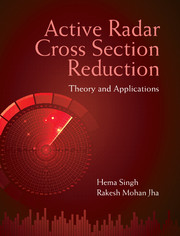Book contents
- Frontmatter
- Dedication
- Contents
- List of Tables
- List of Figures
- List of Abbreviations
- Preface
- Acknowledgements
- 1 Introduction to Radar Cross Section Reduction
- 2 RAM Analysis for Low-Observable Platforms
- 3 Radar Cross Section of Phased Antenna Arrays
- 4 Active RCS Reduction in Phased Arrays
- 5 Mutual Coupling Effects in Phased Arrays
- 6 RCS of Dipole Array Including Mutual Coupling Effects
- 7 Performance of Sidelobe Cancellers in Active RCSR
- 8 Emerging RCSR Techniques
- Epilogue
- Appendices
- List of Symbols
- Suggestions for Further Reading
- Author Index
- Subject Index
5 - Mutual Coupling Effects in Phased Arrays
Published online by Cambridge University Press: 05 April 2015
- Frontmatter
- Dedication
- Contents
- List of Tables
- List of Figures
- List of Abbreviations
- Preface
- Acknowledgements
- 1 Introduction to Radar Cross Section Reduction
- 2 RAM Analysis for Low-Observable Platforms
- 3 Radar Cross Section of Phased Antenna Arrays
- 4 Active RCS Reduction in Phased Arrays
- 5 Mutual Coupling Effects in Phased Arrays
- 6 RCS of Dipole Array Including Mutual Coupling Effects
- 7 Performance of Sidelobe Cancellers in Active RCSR
- 8 Emerging RCSR Techniques
- Epilogue
- Appendices
- List of Symbols
- Suggestions for Further Reading
- Author Index
- Subject Index
Summary
Introduction
When two antennas are placed close to each other, phenomena like reflection, diffraction, scattering and radiation cause interchange of energy between them. This is true irrespective of their being in transmitting or receiving mode. This energy exchange between the antenna elements is identified as mutual coupling effect. The coupling effect in phased array affects the antenna gain and beam width and is dependent on (i) radiation behaviour of each antenna element, (ii) inter-element spacing, (iii) feed network and (iv) the orientation of antenna element respect to the neighbouring element. The coupling effect becomes important especially when the spacing between the antennas is reduced below half-wavelength. The presence of coupling in an array changes the terminal impedances, the reflection coefficients and the array gain of the antennas. These fundamental properties of the array influence its radiation characteristics, output signal-to-interference-noise ratio (SINR) and radar cross section (RCS). Furthermore, it affects the steady-state response, transient response, speed of response, resolution capability, interference rejection ability and direction of arrival (DOA) estimation competence of the array.
Several techniques have been proposed for the estimation and mitigation of mutual coupling effect in different types of adaptive arrays. These include Yagi array (Leviatan et al. 1983), least mean square (LMS) and Applebaum arrays (Gupta and Ksienski 1983), power inversion array (Compton 1979), circular array of isotropic elements and semicircular array of printed dipoles (Fletcher and Darwood 1998), microstrip patch antenna arrays, linear arrays of dipole, sleeve dipole and spiral antennas (Pasala and Friel 1994), conformal dipole arrays (Guo and Li 2009), helical arrays (Hui et al. 2003) and arrays of arbitrary geometry (Strait and Hirasawa 1969).
The parameters governing the array performance are obtained using various techniques like the method of moments (MoM), multiple signal classification (MUSIC), estimation of signal parameters via rotational invariance techniques (ESPRIT), scheme for spatial multiplexing of local elements (SMILE) and direct data domain (DDD) algorithms. The algorithms used to estimate the coupling can be extended towards its compensation. Moreover, optimisation techniques like the genetic algorithm (GA), particle swarm optimisation (PSO) and linear programming (LP) can be used in conjuncture with these techniques towards the enhancement of array efficiency.
- Type
- Chapter
- Information
- Active Radar Cross Section ReductionTheory and Applications, pp. 177 - 215Publisher: Cambridge University PressPrint publication year: 2015

